Story and photos by Chad Love
Prologue
There’s been so much ink spilled about Mearns’ quail hunting in southern Arizona over the past few years that it seems redundant and, quite frankly, more than a little derivative to write yet another story on our most bejeweled and most bucket-listed of native quail species.
So to hell with it, I won’t. You know where to go. You know what they look like. All the standard information is out there, ad nauseum, and the last thing the world needs is one more boilerplate destination-piece travelogue that tells you the same.
So what remains, then, to share about the experience of hunting Mearns’ quail? Perhaps just a few moments, those points in time that stay with you after everything else has fallen away…
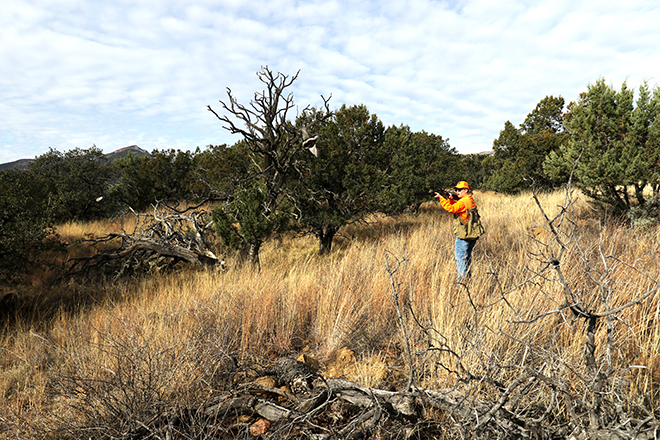
Act 1: The Journey
Mearns’ country is a helluva long way from pretty much everywhere else, including my home in western Oklahoma, which means that getting there is an unavoidably large part of the experience.
As such, I’m on the road by the chime of the witching hour, the truck packed with gear, sleeping dogs and anticipation. I have traced my hands over the lines on the map from here to there so many times that I know the route by heart, if not by actual experience.
I roll through Amarillo in the early-morning darkness, and by the time the sun fully rises over the vestigial ghosts of the Llano Estacado I am crossing not only the state line from Texas into New Mexico, but lines of geology, culture and familiarity. My own world of bobwhites and mixed-grass prairies slowly gives way to the world of desert quail and sparse, hard lands where eons of time and history are laid bare for the viewing, honest and raw.
I make my way down through Roswell (no aliens, but I ponder the tempting proximity of all those scaled quail), across the jaw-dropping beauty of the Capitan mountains and down into the gorgeous, mysterious belly of southern New Mexico.
The place-names drip with history, romance, beauty: Ruidoso, Mescalero, Tularosa, Alamagordo, Las Cruces. There are Mearns’ quail in this area, and I vow to come back and hunt them, but for now I am headed ever west, toward Arizona and the epicenter of the Mearns’ hunting scene.
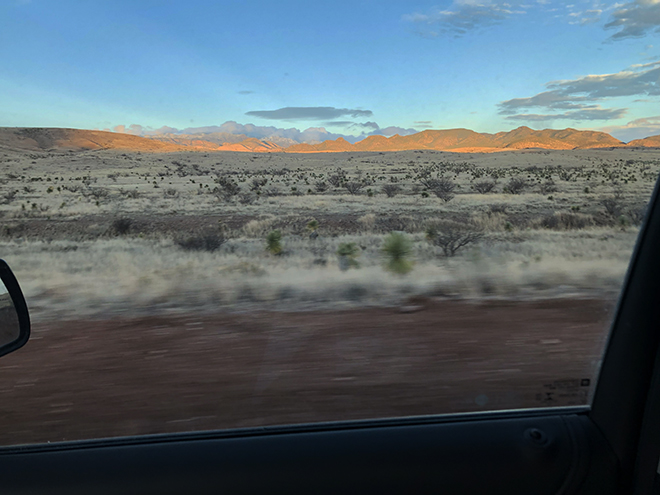
I hit I-10 at Las Cruces and head west. And it is outside Deming, New Mexico where I get my first reminder that I am in another world not only geographically, but socio-politically.
At the checkpoint the Border Patrol agent looks me over cordially but coolly. Deeming me a non-threat, he waves me through. It will be the first of many over the coming days, and it drives home the one overriding, unavoidable truth of hunting in Mearns’ country: This is border country, and as such, there is a constant awareness of that fact that you cannot escape. It is not good, or bad. It simply is. And if you want to hunt Mearns’ quail, you must accept it.
I drive on, and soon enough cross the border into Arizona, into the heart of Mearns’ country, into the storied land of Cochise, Tombstone, and, for some, obsessive dreams of dogs, moments, and precious gems that fly.
Act 2: The Land
The term “sky island” rolls off both the tongue and the mind in a way that drips with evocative imagery, conjuring visions of grand buttresses rising above the firmament, or vast floating cities hovering in the clouds.
And in truth, that’s not too far from the truth. Southern Arizona’s mountain ranges rise above the desert floor like Tolkien-esque castles from another world, because in essence they are. With elevation comes differing biomes and differing natural worlds. And while Mearns’ quail may live in the desert, they are not desert birds, but neotropical citizens of these rarified sky islands.
Arizona has three huntable species of quail, and for the most part, you must ascend to find Mearns’, up past scaled quail, past Gambel’s, and into the oak savanna grasslands that cover the hills and mountains of the sky islands.
I am not a mountain hunter. I am a creature of the plains, and vertical landscapes are not my comfort zone. I must resist the urge to retreat to the known, to go chase scaled quail in the horizontally-familiar landscape of the scrublands. But I am here for Mearns’, so ascend I do, driving ever-upward into the twisting canyons and folds and benches and steep hillsides of Mearns’ country.
And when I reach the places I cannot drive, I walk. Always up, and always far. The first day it snows on me. The second day brings rain. The third? Heat and scorching wind.
Despite this, I am agog at the beauty. The dogs and I walk through a landscape of geological, botanical, and biological wonder. Unknown birds I’ve never seen, unknown birdsong I’ve never heard, plants and grasses and trees totally unknown to my southern plains eyes.
On a steep hillside I find the bleached skull of a javelina. It resembles something from the depths of cryptozoology, as foreign to these Okie eyes as the skull of a yeti. This is indeed a wondrous land.
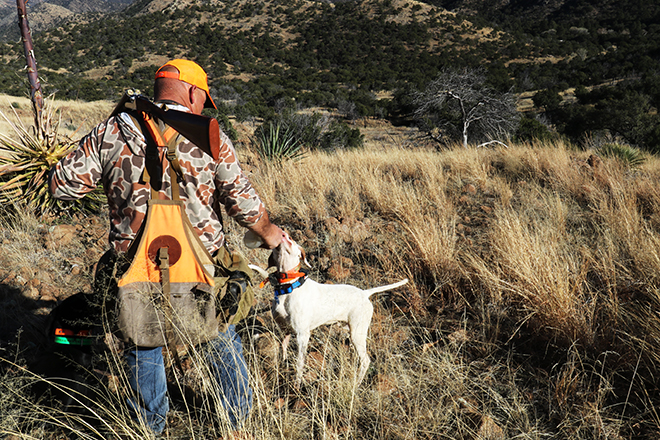
But amongst all the beauty and wonder are reminders that I am in a place where the realities of nature and the sometimes heartbreaking and ugly realities of civilization intersect: An endless stream of border patrol checkpoints and encounters. Signs warning me about illegal activity. In some areas I encounter the detritus of the desperate, the displaced, or perhaps the illicit. I cannot tell, nor can I judge, by what they leave behind.
In one steep and rugged draw leading down to the desert floor, and beyond that, Mexico, I find a child’s shoe. I ponder, uncomfortably, the significance of this, then place the shoe back where I found it. As I race to catch up with the dogs, a favorite quote from a favorite author keeps playing in my mind, something about how the land inherits, and how neither a land nor a people ever starts over clean.
Act 3: The Moment
He’s a young dog, talented but still headstrong and raw. On the plains he stretches out and flows like spring runoff, but here in the vertical horizon of the mountains he has to throttle it back, but only slightly, churning up and down the steep hillsides and ridges, searching for the scent of a bird he’s never encountered but will instinctually know.
In theory, anyway. After a day spent fruitlessly gasping our way across untold numbers of contour lines, we have yet to find a bird, and optimism flags under the withering assault of reality. I’m beginning to wonder if his nose still works, if my brain still works. I second-guess the decision to stubbornly insist on shooting my first Mearns’ on my own, with no assistance, no advice, and no company.
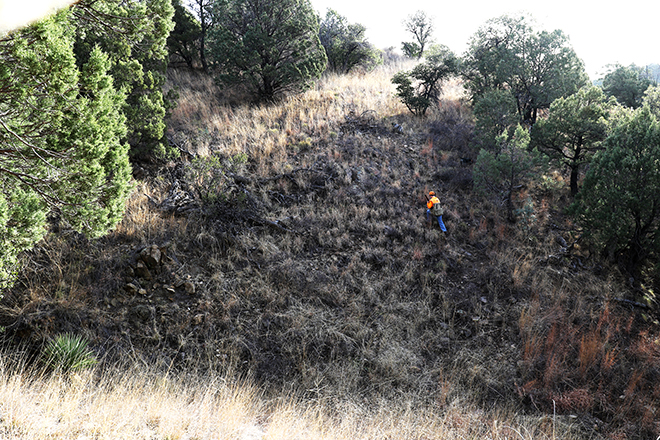
Maybe the dogs and I aren’t quite ready for it, after all. Maybe Arizona is too much for us, despite the heartbreaking beauty. It shouldn’t come as a surprise. “I have very little idea what I’m doing, but I’m going to do it, anyway” has always been my mantra when it comes to hunting new places and new birds.
Sometimes it works, and sometimes it blows up in my face. And right now, I fear it’s the latter.
We are side-hilling a mountain covered with grass, short-statured oak trees, and rocks of the perfect size and shape to roll middle-aged ankles when the dog changes state from fluid motion to utter motionless, staring right at the base of an oak tree that is more shrub than tree. No tell-tale signs, no birdiness, just an instantaneous binary operation, a flip of the switch from on to off.
It’s the first solid point I’ve seen on the trip. I excitedly run-walk-stumble across the carpet of ankle-breakers to where he’s quivering. I try to catch my breath and composure, ready my shotgun, and walk into the point, and straight into the grip of a newfound obsession.
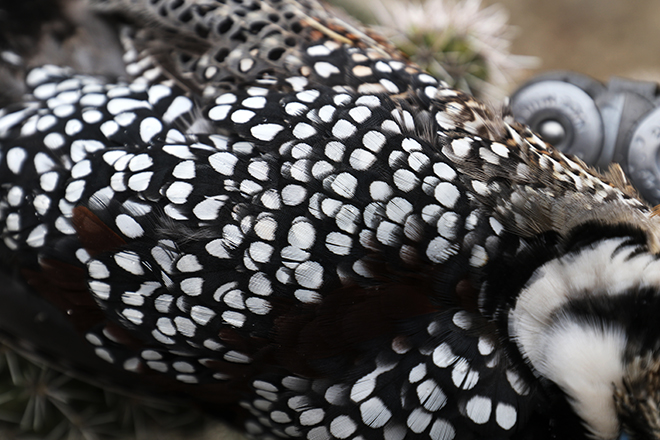
Epilogue
That’s how it is in Mearns’ country. If you go there simply to hunt quail, you will be forced to ponder, perhaps briefly, perhaps more lastingly, things beyond that moment we all seek. And I for one, believe that makes the experience all the more real, and richer.
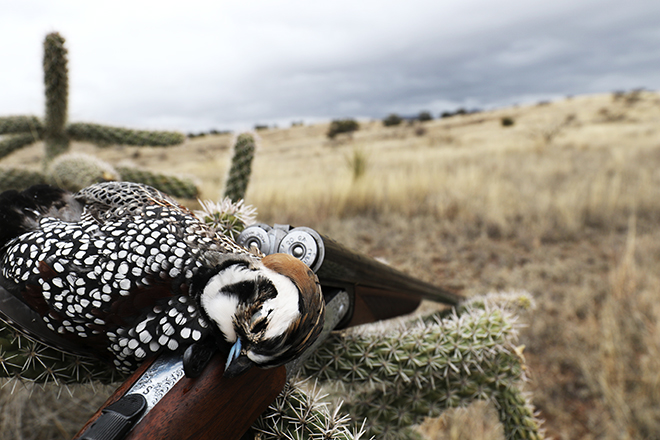
Chad Love is editor of Quail Forever Journal